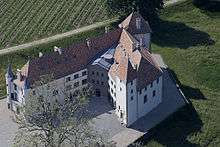Allaman Castle
| Allaman Castle | |
|---|---|
 | |
 Location within Switzerland | |
| General information | |
| Classification | Grade 1 Swiss Heritage Site |
| Town or city | Allaman |
| Country |
|
| Coordinates | 46°28′17″N 6°23′52″E / 46.4713°N 6.3978°ECoordinates: 46°28′17″N 6°23′52″E / 46.4713°N 6.3978°E |
| Website | |
| www.Chateau-Allaman.ch | |
Allaman Castle (French: Château d'Allaman) has its origins in the 11/12th Century but the main components were built by Louis, Duke of Savoy - Count de Vaud, in 1253. It is listed in the Grade 1 Swiss Inventory of Cultural Property of National and Regional Significance.[1]
The wealthy Genevan philanthropist Count Jean-Jacques de Sellon, (son of Hortense Gallatin, the sister of Albert Gallatin) who owned the property until 1839, gave accommodation at the castle to, amongst many others, such political refugees as Napoleon's brother Joseph Bonaparte,[2] Empress Joséphine de Beauharnais, the Duke of Bassano, the Count Camille Cavour, Voltaire as well as to Franz Liszt and George Sand. In 1820 de Sellon founded the Society of Peace, forerunner of the League of Nations and the United Nations Organization (UNO) and in 1830 the First International Peace Summit was held in Château d'Allaman. Since then, the Castle has also been referred to "The Castle of Peace". De Sellon was also instrumental in the abolition of the death penalty in Switzerland.
The Castle of Allaman is one of the largest private properties of Switzerland. The estate covers over 330,000 square metres (33 hectares; 82 acres) and offers some 6,200 m2 (67,000 sq ft) of living space. The estate is surrounded by private forests, parks, gardens and Grand Cru vine yards. Recently completely restored and transformed, the Castle is owned by a Swiss family.
See also
References
- ↑ "Kantonsliste A-Objekte:Vaud" (PDF). KGS Inventar (in German). Federal Office of Civil Protection. 2009. Archived from the original (PDF) on 2011-09-28. Retrieved 12 July 2010.
- ↑ Gallatin, Albert (1916). Diary of James Gallatin. New York: Charles Schribner's Sons. pp. 48–50.
External links
| Wikimedia Commons has media related to Château d'Allaman. |